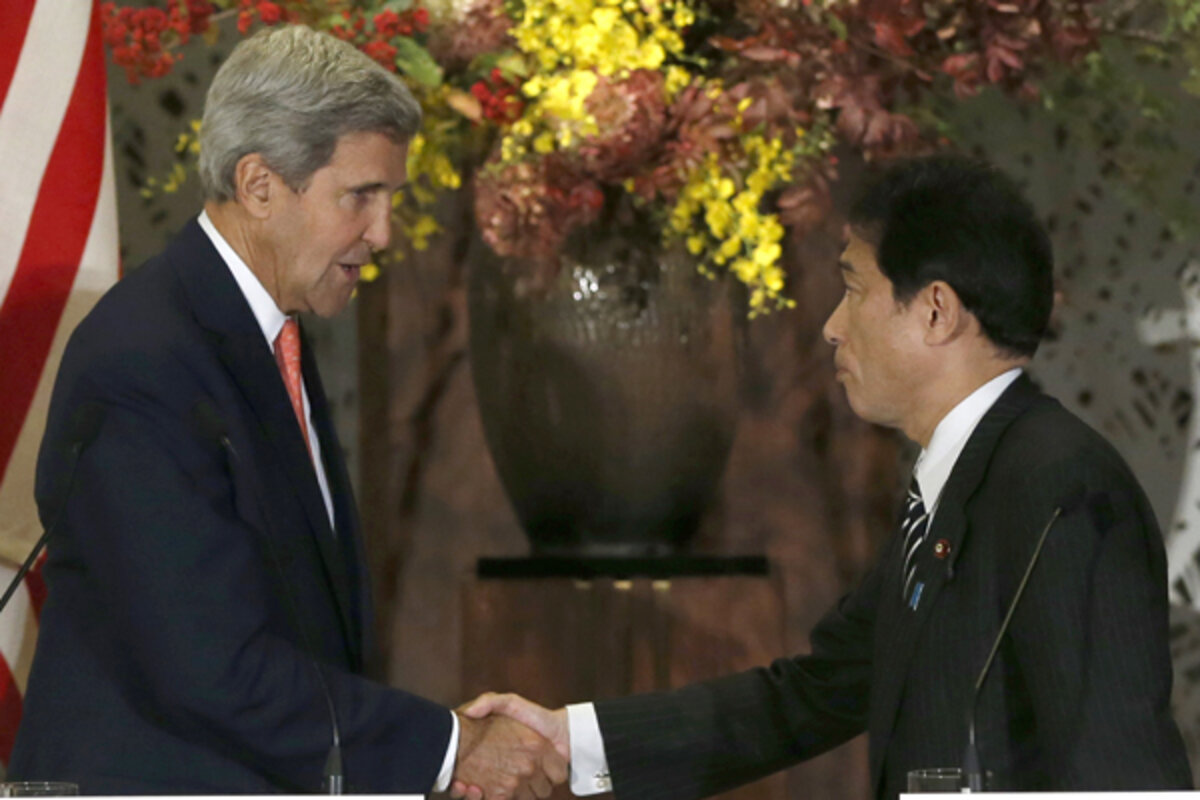Japan, US fortify military ties with drones. Will China take note?
Loading...
| Tokyo
Japan and the US have agreed to strengthen their alliance to address��threats to regional security from North Korea’s missile program and��China’s increasingly robust claims to disputed island territories, in the first broadening of the two powers' military alliance in nearly two decades.
��
The 10-page joint statement, which was finalized by the Japanese and��US defense ministers in Tokyo��on Thursday, included cooperation on��a wide range of issues, from cyber-attacks and terrorism, to security��in space and joint military exercises.
"Japan is changing and so is its neighborhood," US Secretary of��State John Kerry told reporters after the “two-plus-two” meeting between the US and Japanese foreign and defense ministers.��"So we're coming together now to modernize our deep cooperation,��through both our military alliances and our diplomatic partnerships,��and that is so we can better prevent and respond to the ever-changing��threats of the 21st century."
The Asia-Pacific has become vulnerable to new threats in the 16 years��since the allies last revamped their defense partnership.��
North Korea has continued to develop nuclear weapons and a long-range��ballistic missile program, in defiance of the international community.��China, meanwhile, is causing concern with its dramatic rise in��military spending and aggressive claims to maritime territories.
��
Relations between China and Japan have deteriorated sharply in the��past year over their rival claims to the Senkaku islands – known as��the Diaoyu in China – in the East China Sea.
��
With the Senkaku dispute in mind, Tokyo and Washington agreed to��deploy long-range surveillance drones to monitor the islands by next��spring, in a move that could further raise tensions with China.
��
The revamped guidelines do not mention the Senkakus by name, but the��decision to base US Global Hawk drones at American bases in Japan for��the first time is a sign of growing disquiet over frequent Chinese��maritime activity near the islands.
��
Publicly, the US has refused to takes sides over the dispute but��recognizes it must help defend Japanese territory under bilateral��treaty obligations. Japan��administers the islands, which are��uninhabited but surrounded by potentially large deposits of natural��gas. Japan��bought the islands from their private owners just over a��year ago, and argues that China only began voicing a claim in the 1970s, when studies suggested that oil and gas deposits might be found near the islands.��
"We strongly oppose any unilateral or coercive action that seeks to��undermine Japan's administrative control," said US Defense Secretary Chuck Hagel.
��
Japan’s foreign minister, Fumio Kishida, said the security environment��in the Asia-Pacific had become “increasingly severe,” and issued a��thinly veiled warning to China not to raise tensions over the��Senkakus. "We are decidedly opposed to the attempt to change the��status quo through coercion,” he said. “Rule of law is critically��important."
The US and Japanese joint statement urged China to "play a responsible and��constructive role in regional stability and prosperity, to adhere to��international norms of behavior."
Officials in China, which is marking a week-long national holiday, have��yet to respond to the new agreement. The country’s foreign ministry,��however, has previously criticized the deployment of the first��military radar system in Japan, saying it would destabilize the��region.
��
To counter the threat from North Korea, Japan and the US agreed to��position a second X-band radar system in Japan within the next year.��The radar will enable Tokyo to track missiles from the North aimed at��either country.
Mr. Kerry repeated Washington’s offer of a non-aggression treaty with��Pyongyang, provided it abandons its nuclear weapons program and��complies with UN resolutions on ballistic missile development.
At the meeting, the officials, who also included Japan’s defense minister, Itsunori��Onodera, discussed the delicate issue of the US military presence on��the island of Okinawa, home to the bulk of US military bases in Japan.
In a bid to reduce tensions between US troops and Okinawa residents,��Japan agreed to contribute $3.1 billion toward the $8.6 billion��cost of relocating about 9,000 marines from the island, including��5,000 to the US Pacific territory of Guam.
The new defense guidelines come as the Obama administration attempts��to shift its attention on the Asia-Pacific region, and as Japan’s��prime minister, Shinzo Abe, seeks to bolster his country’s military��capabilities.
In a speech in the US last week, Mr. Abe said Japan should no longer be a��“weak link” in global security, and should play a more active role in its��alliance with the US.��





